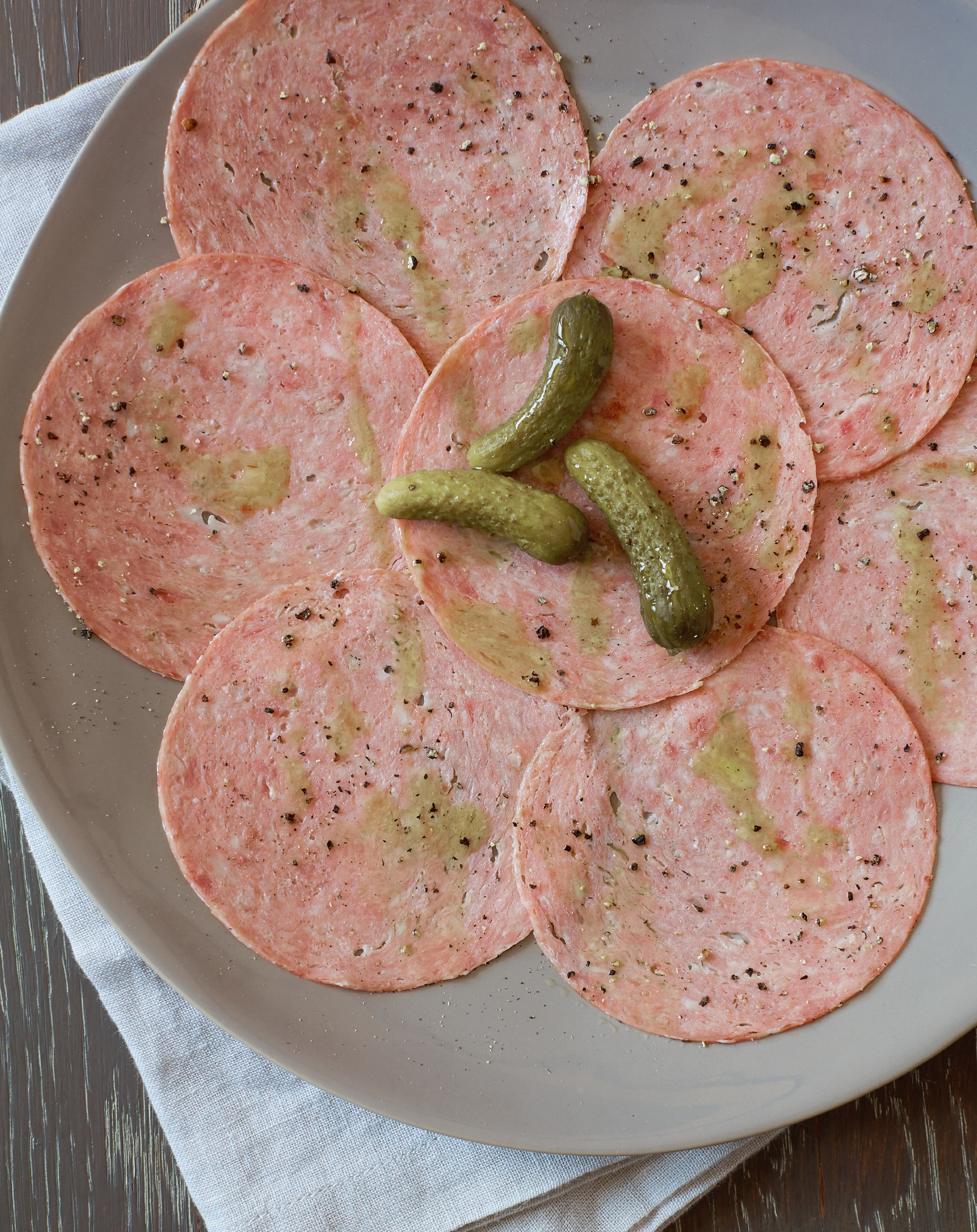
Neal Liston is my in-house butcher. He cuts up the meat, supervises the aging room, and occasionally makes a dish. This headcheese has been a work in progress. I’ve seen him through many evolutions of this, but this is the version that hit all the marks. It’s unique. Traditional headcheese comes from the pig, but we found that the beef version is lighter, creamier, and just as tasty. It has that dense, rich consistency of tongue. All it requires is a cow’s head, which we boil, and we pick all the meat off the skull—everything but the eyes and the brain—and use the natural juices and gelatin in the broth to set the terrine.
By the way, this is an incredible terrine, but it’s not something that I expect a home cook to tackle. It requires a huge cauldron and a huge burner to boil it, and it makes an enormous quantity. That said, if any of you have access to a commercial kitchen and are ambitious, this is a wonderful appetizer and should be served with cornichons and a grainy mustard.
SERVES: 25
1 whole cow head
2 medium yellow onions, diced
4 stalks celery, diced
2 carrots, peeled and diced
1 jalapeño, stemmed, seeded, and ribs removed, diced
1 bunch thyme
2 fresh or dried bay leaves
5 shallots, diced
¾ cup packed chopped cilantro leaves
1 bunch chives, minced
4 tablespoons unseasoned rice wine vinegar
5 tablespoons kosher salt
1 tablespoon freshly ground black pepper
Place the cow’s head in a pot large enough to hold it and cover the head with water. It should be fully submerged. Add the onions, celery, carrots, jalapeño, thyme, and bay leaves.
Bring the water to a simmer (this will take a while, but don’t let it boil) and cook for 5 hours, or until the meat on the head is tender. Test by pulling off a piece of the meat; it should come away easily.
Remove the head to a bowl or rimmed plate and let cool to room temperature. Add any liquid that accumulates back to the pot.
Strain the liquid and discard the solids. You should have about 8 quarts.
Return the liquid to the pot and boil until it has reduced to one-tenth the volume, about 3 cups.
When the head is cooled, pick the meat from the bone, shred it, and reserve in a large bowl.
Remove the tongue from the head and peel off the membrane. Discard the bones and the membrane. Dice the tongue and add to the reserved head meat.
Mix 1¼ cups of the reduced liquid into the tongue and head meat. Add the shallots, cilantro, and chives and stir to mix well.
Add ½ cup of the liquid, the vinegar, salt, and pepper. Mix well and discard the rest of the liquid.
Pour the mixture into a 9 × 5-inch loaf pan, cover with plastic wrap, and refrigerate until firm, at least 24 hours.
When you’re ready to serve, turn the headcheese out of the pan onto a cutting board, and with a very sharp knife, cut into 1-inch-thick slices.
In recent years, both chefs and diners have come to a better understanding of the deep synergies of the ancient art of preservation. Not only does preservation allow a meat protein to be stored for later consumption, the process also magically imbues the meat with more complex and alluring flavors. We see this in everything from beef jerky to salami to bacon.
For a long time I didn’t believe in brining. I just didn’t think that it did anything. But then the pork belly craze hit, and I gave brining a new look. I’d never cooked pork belly before, and the first few times I tried cooking it, it came out bland and fatty. At some point I saw a video of Gordon Ramsay cooking a pork belly that he had brined, and it started to make sense. (See? Even I learn from TV chefs!) Shortly after, a friend made this 30-day brined pork belly, and it was the sweetest, most gelatinous, incredible stuff. My view shifted.
These forms of preservation all start with some degree of salting, either a “wet cure” in the form of a brine or a “dry cure,” which is just a dusting of salt and spices and sometimes sugar. We use both techniques at Knife, less for preservation than for the wonderful, complex flavors with which they imbue the meats. Here are a number of brined and cured appetizers.*